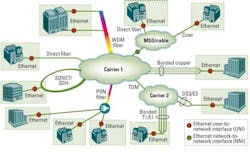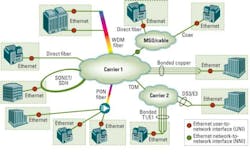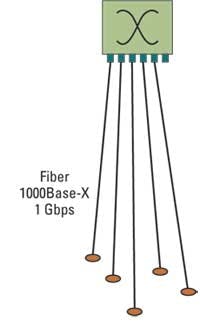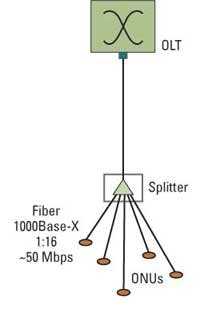Fiber optics among Carrier Ethernet's multiple access technologies
OVERVIEW: Carrier Ethernet's versatility allows service providers to leverage a wide variety of fiber, copper, and wireless access technologies. This article focuses on optical access, a subset of these available options.
The market for Carrier Ethernet services has witnessed tremendous growth in recent years, resulting in a diverse customer base with new demands for manageability and global reach. The Metro Ethernet Forum created Carrier Ethernet by strengthening the traditional LAN-based Ethernet to meet enterprise requirements in metro and long-distance networks, while ensuring service providers can easily deliver those services over a wide variety of physical infrastructures and provide consistent service to all customer locations.
The simplicity of the Ethernet model means that it has been adapted to survive on a wide range of access media, including a number of fiber, copper, and wireless options. This article focuses on the many optical access options for Carrier Ethernet while briefly mentioning other possible access technologies.
Optical fiber is ideal when available
The outstanding advantage of fiber is its huge data-carrying capacity—thousands of copper cables would be required to replace a single high-bandwidth fiber cable. In addition, fiber offers low attenuation, enabling long distances between amplifiers or repeaters, and a lack of interference or crosstalk even when running alongside other cables for long distances.
Fiber, with its high electrical resistance, can conveniently be installed along railway tracks, alongside power lines, and across industrial areas with electromagnetic interference sources, as well as areas of high incidences of lightning strikes without the expense of additional layers of insulation. Other advantages for specific applications include:
- lighter weight than copper cable which, for example, makes it better for use in aircraft
- optical signals cannot generate sparks and so are safer in flammable or explosive atmospheres
- not radiating electromagnetically also means fiber is more difficult to tap without disrupting the signal, which is important in high-security applications
- fiber's smaller cable size is also important in some installations, where smaller channels can be drilled and space saved in existing cable ducts and trays
Figure 1 shows how optical technologies can be combined with a range of access technologies to provide revenue from widespread broadband usage.
Figure 1. Carrier Ethernet access technologies.
Ethernet over optical fiber
Where fiber is available and high bandwidth is needed, optical access is unbeatable. Ethernet over optical fiber, with its virtually unlimited bandwidth, noise immunity, and long reach, delivers the performance needed for today's most demanding applications and the best we can dream up for tomorrow.
The simplest application is to lay a dedicated fiber direct from the provider's aggregation switch to a network interface device (NID) located at the customer premises. This direct fiber approach offers full flexibility for upgrades or technology changes, as each customer receives the benefits of a dedicated fiber (see Fig. 2), but it requires more costly equipment at the headend. The fact that more fiber is used versus other approaches often makes little difference, as fiber is a minor cost item compared to the cost of trenching and laying the network—so the more fibers laid in any one trench, the less the overhead.
Figure 2. A direct fiber approach provides maximum flexibility.
More commonly, each fiber will serve several customers, or more customers are added to an existing link. This shared fiber approach requires a hardware platform somewhere near the customers whose networks share the one fiber (see Fig. 3). The question then is, what sort of link connects the customer into that fiber? If fiber is not available or necessary, it might be an alternative approach such as bonded copper, VDSL, or Ethernet over DOCSIS. If the final access is by fiber, the choice lies between active fiber (active optical networking, or AON) or passive fiber (passive optical networking, or PON).
Figure 3. A shared fiber approach can be used if fiber is not readily available or in scarce supply.
AON is basically the full optical service. Although bandwidth may be shared, each customer gets their own fiber link into the hardware box, which is a sophisticated switch that ensures that each customer gets the service they paid for without contention. With so much bandwidth available, they would never know it was not a direct link. The distances are limited only by the active interface hardware; 2 to 150 km can be easily achieved. The ability to deliver 100-Mbps, 1-Gbps, or even higher Ethernet speeds and to multiplex multiple channels using WDM means virtually unlimited future usage.
One problem with AON is that it requires that hardware box in the field—a costly device that needs an electric power supply and occasional maintenance. PON replaces the box with a small, simple splitter that takes the light from one fiber and splits it equally among several other fibers (see Fig. 4). It is passive in the sense that it requires no electrical systems to read and reroute the signals and no powered lasers to boost them on their way. As a result, the signals are weaker, which sets a limit on the number of downlinks. But up to 128 downlinks traveling up to 40 km is possible, so this approach is useful for serving a housing estate or business park.
Figure 4. PON replaces the powerd hardware platform in the outside plant with a passive splitter.
As a way of delivering signals downstream, this approach is fine. The problem lies with upstream signals and how to stop them from clashing without a switching facility. The optical network unit (ONU) at the customer premises converts the optical signals into signals the premises devices can use and vice versa. For messages going back upstream, however, PON ONUs are designed to take turns with all the other premises at the end of this network section. Each has a brief timeslot to send its messages through the splitter back to the main office where they are received by the optical line terminal (OLT).
This time multiplexing process is so fast that users can happily use the Internet and even make voice calls without being aware of the delay. But it does add a little more cost and complexity to either end of a PON—the IEEE estimated that some 70–80% of the cost lay in the ONUs—but this is relatively insignificant compared to the savings in field-mounted equipment.
PON is a cost-effective access method because it conserves the fiber needed for high-bandwidth business applications while extending services to residential access, greenfield deployments, mobile backhaul, and upgrades from cable or copper networks. The use of passive devices in the field means less maintenance and significantly less money spent on power.
PON comes in a variety of standards, but the key ones today are EPON and GPON, both of which support MEF Carrier Ethernet. The EPON standard was developed by the IEEE and the GPON standard by the ITU. EPON supports 1 Gbps upstream and downstream, while GPON provides 1.25 Gbps upstream and 2.5 Gbps downstream. Standards are also underway at CableLabs for translation of DOCSIS management commands into Ethernet formats to manage EPON fiber access via DOCSIS-based equipment. An upgrade path to 10 Gbps exists for both PON types via work being done at IEEE and ITU-T.
Other approaches
While direct fiber and shared fiber are common ways to provide native Ethernet connectivity, other approaches can be used to transition legacy networks to Carrier Ethernet or for “special cases.”
Ethernet over SONET/SDH (EoS): Fiber networks have been around longer than Carrier Ethernet, and many existing installations run on the highly reliable and familiar WAN standards SONET/SDH. So it made sense for EoS to be developed to provide all the quality of service and flexibility of Carrier Ethernet over the existing service.
Sophisticated MEF-certified services are available from 1 Mbps to greater than 1 Gbps, together with interface cards suitable for modern SONET/SDH transport equipment plus low-cost external devices for use when leasing transport or to upgrade existing SONET/SDH equipment. Modern circuit-bonding protocols, such as virtual concatenation (VCAT), have helped make Ethernet services over SONET/SDH available at fractions of the line rate, eliminating stranded capacity and further driving down costs.
Ethernet over HFC/DOCSIS: Cable-TV and other MSO networks also serve many high-density communities. Typically the provider's fiber-optic network extends from the regional headend to nodes serving from 25 to 2,000 homes via coaxial cable. This hybrid fiber/coax (HFC) network can carry high-speed data using a DOCSIS physical layer. Ethernet over HFC/DOCSIS is a technology that enables cable operators to deliver Carrier Ethernet to the home, small business, and home office market.
Ethernet over FSO: Wireless access can prove useful for temporary access—on construction sites, for instance, or for provisioning greenfield sites ahead of full fiber deployment—or over short distances between tall buildings when laying fiber does not make economic sense.
Free-space optics (FSO) systems send the optical signal point-to-point through the air rather than down a fiber. Gigabit Ethernet speeds can be obtained without the need for purchasing radio spectrum, as the technology is free from licensing and regulation. Limitations include FSO's line-of-sight requirements and susceptibility to weather interference.
Other access technologies: Nonoptical access technologies for Carrier Ethernet include Ethernet over existing copper infrastructure, whether the service provider transports Ethernet over PDH using bonded T1/E1 or DS3/E3 links, or directly over copper (Ethernet in the first mile over copper, or EFMCu). A host of wireless options are also available, such as Ethernet over microwave point-to-point links, Wi-Fi, WiMAX, and a range of existing and developing technologies for mobile broadband access: EVDO, GSM, and LTE.
This article has covered optical alternatives for deploying Ethernet in the last mile and delivering MEF-compliant end-to-end Carrier Ethernet services. Service providers are making large investments to roll out fiber networks, and there is a choice of Ethernet access technologies available to leverage the fiber access infrastructure in place, in addition to a range of nonoptical access technologies for filling in any gaps in the service footprint.
Nan Chen is president of the Metro Ethernet Forum.
ONE-CLICK LINKS
LIGHTWAVE:Metro Ethernet over GPON Enhances Business Services
LIGHTWAVE:Multiplexing Streaming Data in an Ethernet Network
LIGHTWAVE:Carrier Ethernet Improves IP Service Delivery




